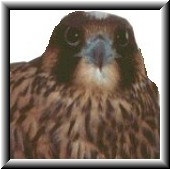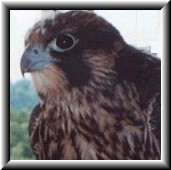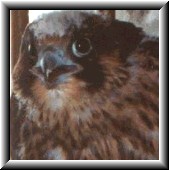Around 12:30 we checked inside the back of the hack box and were
pleased to see that Horus had eaten at least half a quail. The front of
the box was opened again, and Horus soon walked out to the platform. It
wasn't long before he jumped up to the roof of the box and shot us a couple of
stern glares as we retreated up the slope away from the box. He then made
a strong level flight north along the cliff, alighting in a large dead oak tree
beside his brother Aedin. It wasn't long before Aedin moved away, but by
mid-afternoon he flew back to perch beside Horus, and they spent several hours
there together. On a few occasions, Horus was seen preening around the
harness, making sure all of his feathers were back in place - it seems my skills
as a peregrine groomer still leave a bit to be desired! Overall though he
paid the harness and transmitter relatively little attention, as is usually the
case.
Late in the afternoon, Aedin and Horus were joined by Talon, who
landed higher up in the same dead oak. The three of them remained there
for a while, then Talon became a bit rambunctious and the three of them tumbled
into the air play-fighting with one another. All showed strong flight
skills during this brief episode; unfortunately they rapidly disappeared from
view again. Two of them, likely Aedin and Horus, settled in on a slope
some distance north of the hack box, while the other, probably Talon, headed
inland to the west again. Though we anticipated some evening flights, they
never materialized, so by the time we left around 9:00 pm, we had to assume that
Aedin and Horus were settled in for the night where we had last seen them.
The transmitter that Horus is wearing is solar-powered, and if
all goes well, should remain in communication with us for at least one
year. Reports are expected several times per week, and will be posted on
the new Project Track-'em page for
Horus.
Leslie Hunt reports: Horus and Aedin chased a Kingfisher in the morning, but gave up when it landed in a tree. Just before 7am, Horus entered the box and was trapped by biologists to have a satellite transmitter put onto his back. This was done so that his movements can be tracked over the next year or more.
The procedure took a couple of hours. Aedin hung around the cliff site during this time, but did not land on the box. He chased a turkey vulture for a while, and then was harassed by a small bird. Another falcon, likely Talon, made a quick fly-by in the morning. Aedin finally entered the box around 10am to eat. Horus was returned to the box around 11am while Aedin sat on top of the box. Aedin hesitated a while before flying away. Obviously he was not terribly disturbed by human presence. Horus was held in the box for a couple hours to eat and calm down after his ordeal. He joined Aedin in a dead oak tree shortly after release. Talon joined them in the oak in the early evening. Some aerial play/combat took place, and Horus and Talon disappeared for the evening.
Friday July
19, 2002
Leslie Hunt reports: In the early morning, Talon finally landed on the hack box. He landed like a pro. Presumably he went inside. Less than 30min later, he flew north. Aedin and Horus both came back to the box in the morning. Aedin ate while Horus slept. It appeared as though Aedin was guarding the food against
Horus. Horus finally challenged Aedin and successfully ate breakfast after Aedin left the box. In the next few hours, Horus and Aedin made a number of flights, with some impressive landings and some aerial play. Aedin was eating again at 10am, and Horus also had another meal at 10:30am while Aedin slept. Talon made a couple brief appearances (fly-by's) in the early afternoon. Only Aedin was seen eating lunch. Aedin and Horus hung around the box for most of the afternoon, flying here and there. They played, dive-bombed each other, and fought over food. Horus ate supper. No sign of Talon.
Thursday July
18, 2002
Marcel Gahbauer reports: Just a quick note to set at ease all
those who were worried by the disappearing act of the three peregrines
yesterday. Dwayne Struthers called me this evening to let me know that
Aedin came back to the hack box this morning, and spent much of the day there,
in part to digest the quail which he hauled out from inside the box and ate on
the platform, to the delight of the volunteers observing from across the
lake. Horus arrived just this evening, so all three are accounted
for.
Wednesday July
17, 2002
Marcel Gahbauer reports: Today the release went ahead as
planned! Shortly before 8:30 am, Dwayne Struthers gathered up the chicks
one by one, and I inspected them for any remaining signs of frounce/trichomoniasis.
All of them appeared to be in good health, so they were put back inside the hack
box and left to settle down (and have breakfast) for another hour.
At 9:30, Dwayne and I removed the bars from the front of the
hack box. Within a couple of minutes, Talon emerged to the platform out
front. Around 9:33 he took flight, heading out confidently to the east,
heading far across Deer Island, eventually looping around counter-clockwise past
the observers at the north end of Little Deer Island, crossing the lake, and
then heading west over the woods behind the hack box and out of sight. It
was a remarkably strong flight throughout, with no "wobbles" at
all. On a couple of occasions Talon even soared briefly, and when attacked
by a Purple Martin, he showed remarkable composure by ignoring his aggressor
completely.
About ten minutes later, Horus walked out to the front platform
of the hack box. From the island across the channel, we could easily
recognize him by the bleached feathers on the right side of his tail. For
more than an hour, Horus made brief flights from one edge of the hack box to the
other, and included several visits to the roof of the box in his
activities. Throughout this time, Aedin watched from inside the bars
remaining at one corner of the box, seemingly not understanding that he too
could escape!
It was around 11:05 when Aedin finally emerged, and for the next
half hour the two engaged in a fair amount of play-fighting which nearly
resulted in both of them being knocked off the platform at times. Somehow
though they managed to hang on each time.
At 11:36, Horus took off, heading north along the
shoreline. He flew perhaps 100 metres before turning around and heading
back in the direction of the box, making an awkward landing in an oak tree up
the slope from where he had started. Though his flight was not as strong
as Talon's, he nonetheless maintained his altitude well and was in full control
until his landing (and that's always a challenge for young peregrines to
learn). After just a few minutes in the tree, Horus took to the air again,
heading south and then curving inland in the same direction as Talon earlier.
Perhaps feeling a bit lonely, Aedin waited only another twenty
minutes after Horus' departure to take flight himself. He followed the
same route as Horus along the cliff face, but doubled back a couple of times
over the camouflaged tent from which the cliff-top observers were
monitoring. Aedin ended up a bit higher on the slope, near the top of awhite pine. His flight too was quite good, and his landing a bit more
solid than that of Horus. However, he seemed a bit perplexed by all of the
branches surrounding him, as for more than an hour we watched him as he seemed
to be trying to find a way out of the pine, only to get his wings blocked by
branches at every attempt! Finally around 1:10 pm he did find a way out
... and naturally he too headed inland like his younger brothers.
As a result, we spent the afternoon on the lake watching the
rocks and the skyline, waiting for the fledglings to reappear, but by 6:30 pm
none had returned. We suspected that they were not far inland, but in the
dense forest finding them on foot would have been very difficult, so it made
more sense to continue monitoring the hack box area, as they are expected to
return there for food.
As we left the site, Leslie Hunt and I were treated to one of
the great coincidences of timing that sometimes befall us when dealing with
peregrines. Driving out on Lower Oak Leaf Road, we were just passing Slack
Road when we were astonished to see a juvenile peregrine flying toward us, right
over the road! It headed right past us, and veered off to the north and
out of sight. Though we had only a brief look at it, we agreed that it was
a peregrine, and the relatively shallow, stiff wingbeats were consistent with it
being one of the three we released today. This location is approx. 3-4 km
from the hack box, so it appears that at least one of the youngsters (probably
Talon) is trying to make up for lost time! Observers will be watching the
site again all day tomorrow, and hope to see Horus, Aedin, and Talon all return
to the hack box for meals.
Saturday July
13, 2002
Marcel Gahbauer reports: What would a Leeds update be without
news of another delay? Seriously, we had hoped that today's release would
proceed as planned, but once again the birds dictated otherwise. All the
same, it was a very interesting and productive day.
The morning began with several of us running in circles, in part
due to the limited cell phone service in the vicinity of the hack site, which
resulted in several broken and confused conversations. By 9 am these
challenges had been resolved, and we were at the hack box, ready for what was to
be the final step for the chicks before the release - providing them with
"unique identities" to enable observers to quickly tell them apart
from a distance.
Many temporary markers have been used for this purpose,
including coloured paint, streamers, and tape. Today, however, we employed
a new technique which to our knowledge has not been previously used on
peregrines, but which CPF director Mark Nash learned has been applied
successfully to studies of vultures and California condors. In
consultation with the Ontario Ministry of Natural Resources, it was decided to
give this approach a try at Charleston Lake. The method involves bleaching
selected feathers, the location of which is different for each bird at the site
and can be recognized from a distance. For the Charleston Lake site, it
was decided that one chick (Horus) would have the three outermost rectrices
(tail feathers) on his right side bleached, and that Aedin would receive the
reverse treatment, i.e. the three outermost rectrices on his left side.
Talon's feathers were left unmarked.
In brief, the process involves applying a peroxide solution to
the feathers, and immersing them in it for a period of roughly 30 minutes.
Following this, the feathers are thoroughly washed with water to remove any
residues. The feathers will retain this appearance until the bird
undergoes it's first moult at approximately one year of age. Photos to
follow in a few days.
The bleaching treatment appeared to be very successful for Horus
and Aedin, although its effectiveness as a monitoring tool remains to be seen
when they are out of the box and moving around ... which brings us to the fact
that the release did not occur today as originally planned.
While handling the peregrines for the bleaching of feathers,
both Mark Nash and I inspected their condition. On Horus, the first to be
brought out of the box today, Mark noticed evidence of frounce (trichomoniasis)
in the mouth. Having just recently seen similar symptoms on Richmond
Hill's Spirit, he easily recognized the condition and raised the alert.
Fortunately the condition does not appear to be severe, and while Aedin and
Talon were also seen to have some symptoms, their level of infection was even
less extensive.
The incidence of frounce appears to be higher than usual this
spring, both among captive and wild populations of raptors, which some have
attributed the unusually wet spring in Ontario allowing Trichomonas gallinae
to survive and spread at a higher rate. If left untreated, frounce can be
fatal, as it results in the gradual constriction of the airways, beginning in
the mouth and throat and working down into the air sacs of the lungs.
Fortunately, if detected early the treatment for frounce is fairly
straightforward and reliable. It involves orally administering a treatment
for a period of five days.
Thanks are in order to Garnet Baker and Dwayne Struthers who
pursued local veterinarians for medicine once Mark had identified the presence
of frounce, to Pia Gamberg in Kemptville for providing the necessary drugs, to
Ross Struthers for picking them up quickly and bringing them to the hack box,
and to Leslie Hunt for climbing back inside the hack box with the three feisty
young peregrines to capture them individually so that we could provide them with
their first dose of the medicine (after having already gone through this
exercise earlier in the day when they were first examined!). Just as
importantly, thanks to all of the volunteers who waited patiently for the
release from their assorted vantage points, ultimately in vain, but who were
uniformly understanding about the delays.
The problem caused by this is that to ensure all three chicks
will receive the full treatment, they must be kept in captivity for its
duration. Thus, the release has had to be pushed back by five days, and is
now scheduled to occur on Wednesday July 17, around 8:30 am. Of course
this means that volunteer shifts have been adjusted once more. The
Fledgling Watch will now run from Wednesday July 17 through Wednesday July
24. Those who have already signed up for dates between July 17 and 20
(inclusive) need not change their plans; if you have not yet committed to a timeor were previously scheduled for July 14-16, please consider coming instead in
the period of July 21-24. As in the original plans, there will be three shifts each day, 5am-11am, 11am-4pm, and
4pm-9pm. Mornings, although they start early, are often the most
interesting time to observe the peregrines, and there are still holes in the
schedule for many of the mornings. To volunteer for one or more periods,
please contact project coordinator Leslie Hunt at leslie.hunt@mnr.gov.on.ca
or (613) 258-8417.
While the postponement of the release was disappointing for all
who gathered at the site today, the gorgeous weather ensured that everyone had
an enjoyable day all the same. Observers also had plenty of birds to
occupy their attention while the peregrines remained confined - at least half a
dozen Turkey Vultures made periodic appearances in the area, and an Osprey was
seen early in the morning. Particularly conspicuous were the local
Red-shouldered Hawks, which made several low flights near the hack box (likely
coincidental rather than intentional) and were heard vocalizing persistently on
a number of occasions. A rather tame Common Loon entertained many of those
on the water, and the Great Blue Herons demonstrated their fishing prowess
throughout the day. The woods were also alive with the sounds of a wide
variety of songbirds, ranging from Great Crested Flycatchers to Black-throated
Green Warblers to a Scarlet Tanager.
Wednesday July
10, 2002
Marcel Gahbauer reports: Based on a review of the chicks'
physical development on Monday, the release has been pushed back to Saturday
July 13. While they might have been ready to go today, it is better to err
on the side of caution, so this delay will allow them to strengthen their flight
muscles further before they need to put them to the test. The volunteer
Fledgling Watch will therefore be adjusted to run from July 13 through July 20;
additional help is still needed - details on how to become involved are in the
July 8 report below.
Monday July
8, 2002
Marcel Gahbauer reports: The three chicks have made a lot
of progress toward becoming flight-ready over the past ten days since they were
banded. See the latest photos of them in the Leeds
Gallery, which show that they have already lost most of their down
feathers.
Additional volunteers are still needed for help with the
Fledgling Watch, which will commence with their release this Wednesday morning
(July 10) and continue for a week, wrapping up on Wednesday July 18. There
are three shifts each day, 5am-11am, 11am-4pm, and
4pm-9pm. Mornings, although they start early, are often the most
interesting time to observe the peregrines, and there are still holes in the
schedule for many of the mornings. To volunteer for one or more shifts,
please contact project coordinator Leslie Hunt at leslie.hunt@mnr.gov.on.ca
or (613) 258-8417.
Sunday June
30, 2002
Marcel Gahbauer reports: See the Leeds
Gallery for photos of the banding event, and closeups of each of the
three chicks.
Thursday June
27, 2002
Marcel Gahbauer reports: Before getting to the report
on today's banding, an administrative note. Due to the ages of the chicks
being slightly younger than initially expected, their release has been delayed
by a few days. It is now planned for Wednesday July 10, with the volunteer
watch beginning that morning and continuing through to Wednesday July 17.
If you are interested in volunteering, please contact Leslie Hunt (see the June
11 message below for details and her phone/e-mail information).
This morning, representatives of the Leeds County Stewardship
Council, Canadian Peregrine Foundation, Ontario Ministry of Natural Resources,
and many project sponsors gathered at the Athens District High School to welcome
the chicks for the 2002 Charleston Lake hack release.
As we removed the chicks from the transport box, each was first
weighed to determine sex, and then aged based on feather development. We
found that we had three males ranging from 27 to 30 days in age.
After being weighed, each chick received a red two-character
band on the left leg for visual identification, and a standard silver US Fish
and Wildlife Service band on the right leg. Today I had the honour of
banding the peregrines, with the assistance of Pud Hunter of OMNR.
I can honestly say that these three chicks are among the
strongest and most agile male peregrines I've held - getting them out of the
original transport box was no easy feat, and even holding them during the
banding was a bit more of a challenge than is usually the case. This
strength and vigour bodes well for their release in less than two weeks.
Gary Nielsen of the Leeds County Stewardship Council announced
the names of the chicks, the result of a contest held in the community over
recent weeks. In order of increasing age, the chicks will be known as
Horus, Talon, and Aedin.
After the banding was completed, the three youngsters were
transported to their hack box overlooking Charleston Lake. They will
remain there for the next couple of weeks, getting used to their surroundings
while developing additional muscle mass and completing the development of their
flight feathers. The release has been scheduled so that the youngest of
the three will be 40 days old at that time.
Regular updates from the site will again be published this
year. However, thanks to the work of a group of students from Athens
District High School, these reports will for the most part be hosted on the Leeds
County Peregrine Falcon Project Website, along with photos, the live
webcam, and links to a variety of additional topics. Occasional news will
also continue to be posted on this page, so please keep checking here, or on the
main CPF news page for updates as well.
Tuesday June
11, 2002
Leslie Hunt reports: It is now official ... the
peregrine falcon watch on Charleston Lake will start July 7th and run until July 14th (Sunday to
Sunday) [note: effective June 27, this has been changed
to Wed July 10 - Wed July 17].
There will be 3 shifts each day: 5am-11am, 11am-4pm, and
4pm-9pm. You can volunteer for as many as you like. We will pick you
up at the main dock (about 10 min before the start of the shift) and ferry you
to the site. At the site, you have the choice of being posted on an
island, in a boat, or up on the cliff. Your job will be to keep an eye on
the falcon fledglings. You will be supplied with everything you'll need,
although there is never a guarantee that we will have enough binoculars for everyone. If you have a pair, I would recommend
bringing them along.
IMPORTANT... if you are interested, please let me know when you would like to be
scheduled. As much as we would love to have eager beavers showing up unannounced, it will make things quite complicated. One more note... 5am
sounds painful, but it is the most active and exciting shift!!!
Please note that the DEADLINE for signing up is JULY 3.
Leslie Hunt
Species at Risk Project
Ministry of Natural Resources
Kemptville District
phone: (613) 258-8417
fax: (613) 258-9610
leslie.hunt@mnr.gov.on.ca
Sunday June
9, 2002
Marcel Gahbauer reports: The second season of Project
Release in Leeds County will soon be underway! Tentatively the chicks are
set to arrive on Thursday June 27, at which time they will be banded and placed
in the hack box. Confirmation of this date, and further details about the
banding event and additional opportunities for public involvement will be posted
on this page shortly.
Sunday June
2, 2002
Marcel Gahbauer reports: After spending more than eight
months in New York City, Ruby returned to southern Ontario in late April.
Initially she appeared to be heading right back to Charleston Lake, but then she
veered to the left, and landed in Trenton, where she was actually caught during
routine airport protection activities by falconers at the Trenton military
airport. She was in great condition, and we took the opportunity to remove
her transmitter - while this unfortunately means we won't be able to follow her
travels anymore, the likelihood is that the battery would have soon failed
anyway, and recovering the unit at this point allows us to renew it for use on
another bird later this summer.











